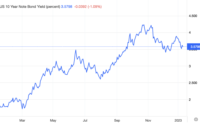Short Is Hot in Credit Markets
(Bloomberg) — Money managers are fortifying portfolios and hedging the risk of a prolonged inflation fight by sticking to credit maturing in just a few years.
Most Read from Bloomberg
Some funds are actively cutting so-called duration, a measure of sensitivity to interest rates, to limit the fallout if central banks keep hiking to tackle inflation. Others are simply focusing on short-dated notes as the additional yield they get from longer securities is too small to justify the risk of a slump when rates rise.
This reflects a broader trend of increasing caution among buyers of investment-grade corporate bonds, who are seeing profits from earlier this year slip away. After galloping to a record total return in January, global high-grade bonds have shed almost four-fifths of their 2023 gains this month to just 1.1%, according to Bloomberg indexes.
“It is a naive person who thinks we do straight line positive returns,” said Richard Hodges, who manages Nomura’s global dynamic bond fund and has reduced the rate sensitivity of his portfolio. His portfolio’s duration is less than a third of the US benchmark’s average and even less for euro-investment grade, which means he risks a much smaller price drop when yields rise.
“It is called tactical management,” said Hodges. “I look upon this as an opportunity,” he said, expecting yields to end the year lower.
Fund moves like this have come amid a shift in trader expectations that central banks may not yet have neared the end of their tightening cycle. Solid economic health-checks in the US and Europe in recent days have fanned fears that policy makers will be able to keep raising rates without risking a steep recession.
Long-dated bonds will be more vulnerable to price drops, but typically tend to offer higher yields than short notes, luring investors with the promise of higher income. However, this argument in their favor has weakened further this year: short bonds’ yields have jumped relative to their longer peers, allowing bondholders to earn lofty yields without swallowing the risk of bigger price swings.
A high-grade corporate bond in the US with a maturity of 10 years pays about 20 basis points more than a two-year issue, down from almost 40 basis points at the start of the year. In the euro market, this gap has shrunk to 24 basis points from almost 60 basis points.
“We’re sitting probably at the lower end of duration, at around two years and about five years in hybrids, as there is a nice yield available and we’re not getting paid to extend it,” said Peter Doherty, head of fixed income at Sanlam Investments UK Ltd.
While rising government yields have squeezed corporate bond returns, credit spreads remain near their lowest levels in almost a year following a rally since mid-October. Even they could be at risk if yields keep rising.
Last week, strategists at JPMorgan Chase & Co. led by Matthew Bailey wondered how much higher rates need to go for credit funds to switch from hunting for value to seeing outflows and selling that would cause spreads to widen. “In our view, we are already approaching that threshold,” they wrote in a note to clients.
To be sure, bondholders can still rely on some of the highest yields since the global financial crisis to cushion some of the mark-to-market losses. But given the shrinking yield gap between short and long bonds, they will want to focus on the less volatile segments.
“If you are on the shorter end, you are almost certain to generate positive total and excess return on a one-year horizon,” said Fabrizio Viola, fixed income portfolio manager at Generali Investments Partners. “We’re staying in the one to five-year part of the curve now and are waiting for better entry opportunities in the long end.”
(Updates charts, figures throughout, adds credit market news.)
Most Read from Bloomberg Businessweek
©2023 Bloomberg L.P.
[ad_2]
Source link


